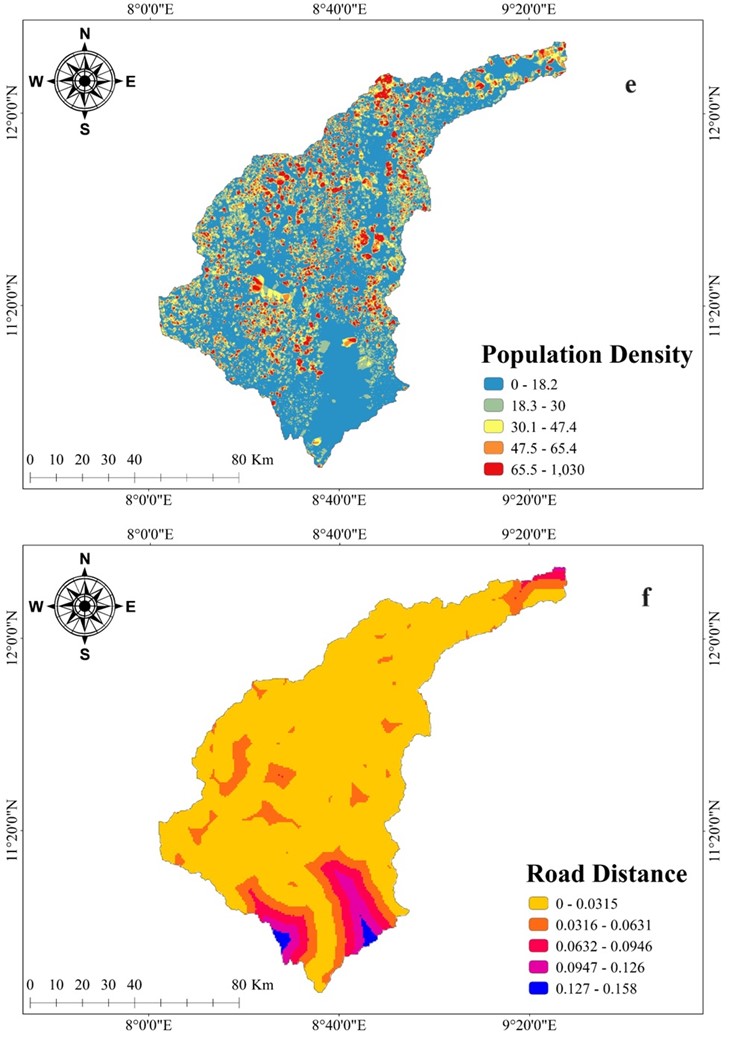IMPACT OF LAND USE AND LAND COVER (LULC) CHANGES ON FLOOD RISK IN THE DOWNSTREAM COMMUNITIES OF THE TIGA DAM, KANO RIVER, NIGERIA
Keywords:
Land Use, Land Cover, Flood Risk, Remote Sensing, GIS, Tiga DamAbstract
Landuse and land cover (LULC) changes significantly influence hydrological systems, especially in semi-arid regions where such changes amplify flood risks. This study examines the spatiotemporal dynamics of LULC between 2009 and 2023 and their implications for flood risk in downstream communities of the Tiga Dam, Kano State, Nigeria. Using remote sensing and Geographic Information System (GIS) techniques, the analysis reveals a notable decline in shrubland cover from 50.57% in 2009 to 43.33% in 2023, alongside an increase in agricultural land from 19.81% to 23.04%. These changes reflect substantial vegetation loss and land conversion, which have increased surface runoff and reduced infiltration. Hydrological modeling confirms that urban expansion and deforestation have intensified both the frequency and severity of floods in the region. Projections based on current trends indicate continued vegetation degradation and urban sprawl by 2050, elevating future flood risks. The findings underscore the urgent need for sustainable land management practices, including afforestation, conservation agriculture, and effective land-use regulation. Furthermore, integrating geospatial data with hydrodynamic modeling provides critical insights for identifying flood-prone zones and designing risk mitigation strategies. This study highlights the importance of evidence-based, proactive land-use planning to strengthen climate resilience and reduce flood vulnerability. As climate variability and human pressures persist, targeted interventions are crucial to safeguard lives, livelihoods, and infrastructure in vulnerable floodplain areas.

Published
How to Cite
Issue
Section
Copyright (c) 2025 Abdullahi Balarabe, E. O. Iguisi, Ibrahim Mukhtar, Z. R. Lawal, Abdulrazak Ahmed, Jibril Haruna Umar, Suleiman Adoga Salihu, Abdulhakim Wagini Hassan, Y. Haliru, M. H. Aliyu, Usama Salisu Khalid

This work is licensed under a Creative Commons Attribution 4.0 International License.
How to Cite
Most read articles by the same author(s)
- I. Mukhtar, E. O. Iguisi, A. U. Shehu, Yusuf Dabo, M. Abubakar, S. M. Zubairu, A. Balarabe, EFFECTS OF LANDUSE AND LANDCOVER CHANGE ON FLOODING IN KANO METROPOLIS, KANO STATE, NIGERIA , FUDMA JOURNAL OF SCIENCES: Vol. 4 No. 3 (2020): FUDMA Journal of Sciences - Vol. 4 No. 3
- A. B. Adegbehin, E. O. Iguisi, Y. O. Yusuf, C. K. Dauda, CLIMATE VARIABILITY AND IMPACT VULNERABILITY STATUS OF IRRIGATION WATER RESOURCES ON RICE AND TOMATO PRODUCTION DOWNSTREAM OF TIGA DAM, NIGERIA , FUDMA JOURNAL OF SCIENCES: Vol. 5 No. 1 (2021): FUDMA Journal of Sciences - Vol. 5 No. 1
- K. O. Ezenwa, E. O. Iguisi, Y. O. Yusuf, M. Ismail, A SCS-CN TECHNIQUE FOR GEOSPATIAL ESTIMATION OF RUNOFF PEAK DISCHARGE IN THE KUBANNI DRAINAGE BASIN, ZARIA, NIGERIA , FUDMA JOURNAL OF SCIENCES: Vol. 6 No. 1 (2022): FUDMA Journal of Sciences - Vol. 6 No. 1
- C. Ndabula, E. O. Iguisi, G. G. Jidauna, K. Oyatayo, D. J. Nyomo, ANALYSIS OF SPATIO-TEMPORAL PATTERNS OF HYDRO-GEOMORPHIC SENSITIVITY AREAS AND DESERTIFICATION STATUS IN A PART OF BORNO-YOBE SEMI-ARID ZONE OF NIGERIA , FUDMA JOURNAL OF SCIENCES: Vol. 1 No. 1 (2017): FUDMA Journal of Sciences - Vol. 1 No. 1
- Abdullahi Balarabe, Ibrahim Mukhtar, Abdulrazak Ahmed, Abdulhakim Wagini Hassan, Jibril Haruna Umar, Suleiman Adoga Salihu, Olorunshola Sherifat Aliyu, Y. Haliru, Usama Salisu Khalid, M. H. Aliyu, ASSESSING FLOOD RISK AND COMMUNITY VULNERABILITY TO A HYPOTHETICAL TIGA DAM FAILURE ON THE KANO RIVER, NIGERIA , FUDMA JOURNAL OF SCIENCES: Vol. 9 No. 11 (2025): FUDMA Journal of Sciences - Vol. 9 No. 11




